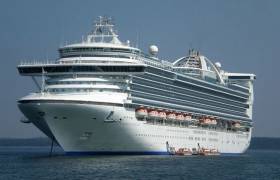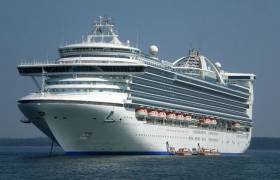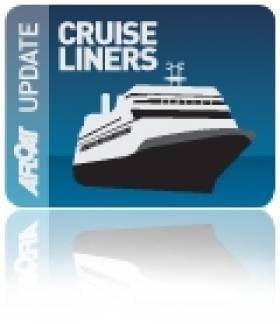Displaying items by tag: Caribbean Princess
Inquiry As to Why Cruiseship Lost Power In Irish Sea
#Inquiry - An investigation has been initiated by Bermuda, writes Irish Times, into how a “mega-class” cruise ship with almost 4,500 people on board spent nine hours drifting without power in the Irish Sea
As reported on Afloat earlier this month, the 290-metre Caribbean Princess was forced to abandon a scheduled visit to Dublin Port after the serious incident occurred 25 miles southeast of the capital off the Wicklow coast on August 3rd.
The 17-deck ship eventually regained power that evening and made its way to Belfast port, where it berthed in the early hours of August 4th.
Bermuda, the British overseas territory which is the port of registry for the ship, said it had continuously monitored the vessel’s situation “from the time of its propulsion failure until the full propulsion power was restored and its voyage to Belfast completed”.
The Bermuda Administration said it had been in “constant communication” with the British Maritime and Coastguard Agency on the incident. Holyhead Coast Guard despatched a tug and helicopter to the ship, which had 3,306 passengers and 1,158 crew on board when it lost power on its route up the Irish Sea. The ship had been en route from Cobh to Dublin as part of a 12-day cruise from Southampton.
For more on the incident, the newspaper has more here. Afloat adds the cruiseship is today docked in Dublin Port, having called to Cobh, Cork Harbour.
Power Failure Strands Cruise Liner In Irish Sea
#CruiseLiners - A power failure on board a large cruise liner rendered the vessel adrift in the Irish Sea for nine hours earlier this week, as The Irish Times reports.
The "technical glitch" on the Caribbean Princess cut power to the engines when the 290m liner was close to the shore off Wicklow on Wednesday (3 August).
The Grand Class cruise ship was en route to Dublin Port from Cobh where it made a stopover the previous day.
Once power was restored, the vessel proceeded to the Port of Belfast, skipping its scheduled stop in Dublin – which it last visited in May, as previously reported on Afloat.ie.
The Irish Times has more on the story HERE.
Cruiseship on Atlantic Repositioning Cruise
#ATLANTIC REPOSITIONING CRUISE – Another massive cruiseship the Caribbean Princess (2004/112,894grt), is to dock in Dublin Port around lunchtime today, having crossed the Atlantic, from Halifax, Nova Scotia in Canada, writes Jehan Ashmore.
The 3,600 passenger capacity 'Grand' class ship operated by Princess Cruises is on a repositioning cruise voyage from North America to Europe. She is to spend the season running cruises based out of Southampton.
Caribbean Princess retains her 'Skywalkers' Nightclub mounted 15 decks at the stern, unlike her sister which called to Dublin Port last month. The structure was removed primarily on grounds of weight so to increase fuel efficiency.
The Bermuda flagged vessel is to berth at Ocean Pier in the centre of the docks which this season is to welcome a total of 90 cruiseships bringing 100,000 passengers contributing €35- €50m to the Dublin economy in 2012. It is estimated that the cruise sector has contributed over €350 million to the capital in the last decade.
Vessels such as the Caribbean Princess and larger-sized ships could be a familar sight closer to the city-centre should proposals to build a €30m dedicated cruise terminal take-off at a site adjacent to the East-Link Bridge, as part of the Dublin Port Company's Masterplan 2012-2040.































































